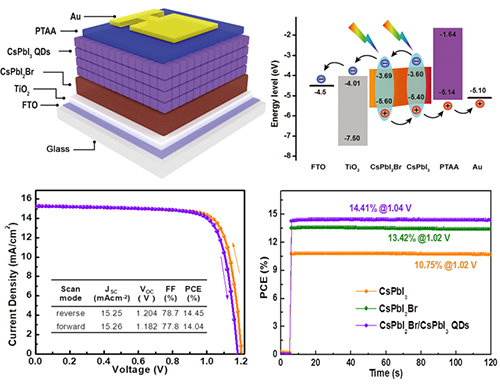
A research team led by Prof. LIU Shengzhong from the Dalian Institute of Chemical Physics (DICP) of the Chinese Academy of Sciences and Dr. JIN Zhiwen from Shaanxi Normal University fabricated inorganic perovskite solar cells with a record high stabilized efficiency of 14.4%. Their findings were published in Joule.
The most popular perovskite composition for photovoltaic applications is the organic-inorganic hybrid one with power conversion efficiency (PCE) as high as 22.7%. However, such hybrids suffer from poor photochemical and thermal stability owing to their volatile organic component. It is expected that the stability will be much improved if the organic cations are replaced by the inorganic ones.

Schematic structure, energy-level diagram and device performance. (Image by JIN Zhiwen)
Recently, all-inorganic perovskite CsPbI2Br and CsPbI3 quantum dots (QDs) based solar cells are found to have excellent ambient phase stability. Unfortunately, their bandgap is too large and the current density is too low.
The researchers countered this problem by developing a bandgap grading cell structure, in which the CsPbI2Br film was used for the bottom component and the CsPbI3 QDs for the top one. As a result, the fabricated device could achieve the cell efficiency as high as 14.45%, which is the highest for inorganic perovskite solar cells to date.
It is expected that the record efficiency demonstrated using the graded bandgap design will stimulate significant interest in overcoming the present hurdles to achieve high efficiency and high stability.

86-10-68597521 (day)
86-10-68597289 (night)

52 Sanlihe Rd., Xicheng District,
Beijing, China (100864)

